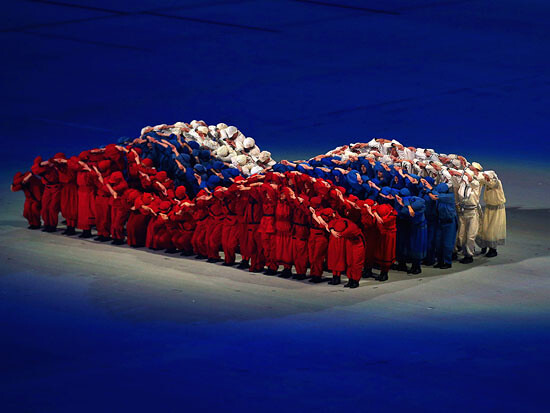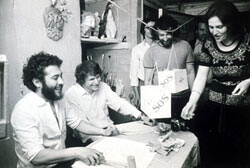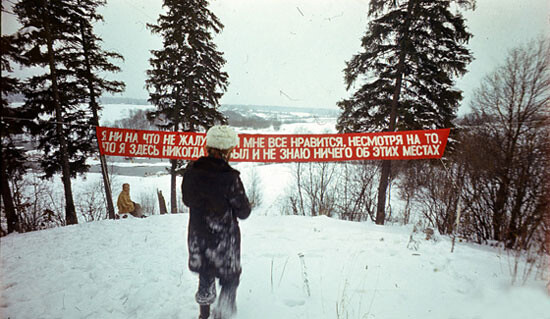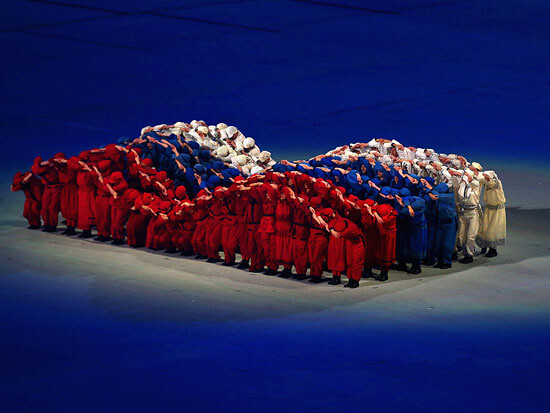Ever since Russia annexed Crimea and a quick clampdown started at home, the mass media, social media, and blogs have all been saying one thing: it’s back to the USSR. The Olympics at Sochi are like Moscow in 1980, the trials of the May 6 protesters or of Pussy Riot like the show trials of 1937, and Russia’s invasion of Crimea is the 1968 Soviet occupation of Czechoslovakia all over again. Like all metaphors, such analogies are political judgements, usually informed by liberal images of the USSR as a realm of necessity and violence, in contrast to the “normal,” “Western” path of development. The regime, in turn, enlists fragments of the Soviet past (for example, the myth of the Second World War) and uses them for its own purposes, as tools for its great-power conservatism, skillfully manipulating the older generation’s nostalgia, including that of Crimeans. If one looks more closely, it is easy to see that both liberal and Putinist-conservative understandings of the analogy between contemporary Russia and the USSR are mirror images of each other. I would like to problematize this analogy without rejecting it entirely, while leaving behind the binary oppositions between the USSR and the West—between us and them.


There are a few obvious things. Liberals like Irina Prokhorova like to imply that there is currently a general economic and political return to the Soviet Union, but this is simply not the case. True, capital and state are interwoven more than ever, and there are problems with doing business independently of the state. At the same time, Russia has joined the WTO, is cutting social spending, and is destroying free medical care and education. There is also something deceptive in the similarities between Putin’s “vertical of power” and the nomenclature of the Soviet-era Communist Party, many former members of which are now part of the new system: a massive change in the base has prompted a mutation in the superstructure. The Soviet “vertical of power” was integrated into society and the economy in completely different ways, and despite all its superficial displays of power, it still set up a very different system of values for its members than United Russia, today’s ruling party. It was, let’s say, more responsible and less oriented toward personal luxury. More often than not, references to the return of the Soviet Union do not concern the economy or the political system, but culture, ideology, and the politics of identity. The Russian state really is using Soviet expertise to repress freedom of speech and manipulate facts. But there is a considerable difference in how state propaganda was constructed in the USSR and how it is constructed in the Russian Federation today.
Soviet mass media and other cultural institutions, including museums, may have silenced dissent and lied, but they retained Enlightenment ideals—maybe using them only as a fig leaf, but still: these were ideals of universal and universally accessible knowledge. Huge editions of fat periodicals and unread scholarly books full of diagrams and charts still burden the shelves of any provincial library, where they now stand next to Darya Dontsova’s latest detective pulp. In terms of form, Soviet propaganda continued to believe, if only by inertia, in the possibility of universal human knowledge and universally applicable human truth. The real point of its content, though, was quite different, addressed as it was to a narrow circle of interested individuals. Statistical summaries in provincial papers would be full of hints about which kolkhoz head would receive an award, and which collective would receive a bonus—often a function of some corrupt scheme. One can see this flip side of Soviet bureaucracy exposed in the screenplays of Alexander Gelman, but exposed from the standpoint of late Soviet ideals, in the hope of recouping their meaning.


Today’s propaganda lacks that dimension of generally human, universal truth—a dimension that allows Alain Badiou to talk about the truth of the October Revolution as an event addressed to the world at large, as opposed to the National Socialist coup d’état, which was addressed to only one nation. Contemporary Russia propaganda manipulates its audience with jingoistic language, appropriating rhetoric from the time of the Cold War as a weapon of nationalism. Of course, there was more than enough nationalism in Soviet propaganda under Stalin and afterward, but it was always linked to the specters of universal, global thinking: the specters of Marx. The new Russian propaganda does not follow Soviet principles of “propaganda and enlightenment,” but instead the capitalist logic of “propaganda and entertainment.” Like any commodity, this brand of propaganda is highly differentiated and oriented toward different target groups of consumers. It does not cater to producers, as was the case with those half-invented statistics in provincial newspapers.
I should clarify, to avoid misunderstandings: the question is not whether there was more or less freedom in the USSR than there is today; obviously, there are many more possibilities to express ourselves freely today, and we use them enthusiastically, although they are not available to all layers of society. The issue in question is the ideology of the state: compared to the flatness of the more and more openly nationalist ideology of Putin’s Russia, Soviet ideology had an extra surplus dimension. Due to this dimension, Soviet artists related differently to the dominant ideology than Russian artists do today.


In so-called Sots Art from the seventies and eighties, artists would appropriate Soviet ideology in such a manner as to reveal the paradoxical significance of its emptiness. They revealed this not only by appropriating the repressive symbols of power, but also by conveying a sense of the lost meaning of these symbols. The specter of this lost universal meaning is especially palpable in absurd privatizations of supposedly “universal” sayings, as in Komar and Melamid’s Slogans, where the artists sign their names below familiar slogans like “All Hail Labor” or “Our Goal is Communism,” thus actualizing the problematic of the universal and the particular. In Collective Actions Group’s famous banner I’m Not Complaining about Anything, and I Like It All, Even Though I’ve Never Been Here and Know Nothing of This Place, there is a similar shifting of registers, from a slogan addressed to everyone to a purely personal confession. By deploying this rhetoric in such a paradoxical fashion, these artists revealed that the universal form of address, directed at the universal human being at the base of the Soviet project, had become empty. At the same time, these artists were fascinated by this emptiness; although the rhetoric of utopia had been hollowed out, it still retained its capacity to point toward some other, transcendental dimension.


Soviet artists (as well as filmmakers, writers, and composers) were forced by censorship to make these ambivalent, ambiguous gestures. There is nothing comparable in contemporary Russian art. Artists today engage in a buffoonish direct dialogue with power, as in Voina’s Priestocop (Mentopop) or C*CK Held Hostage by the FSB, which emulate the logic of domination. Voina’s pranks are constructed as mirror-images reflecting the brute, Gulag-style force with which the state thinks and acts today. In Maria Godovana’s video about the Russian Duma’s passage of legislation against “the propaganda of homosexuality amongst minors” and Putin’s speech on the annexation of Crimea, there is no hidden dimension to Russian ideology; its otherness is that of a dumb and dangerous monster which inspires both mockery and fear. In Godavana’s video, the speeches of Putin and the Duma representatives are inhuman productions of noise: anti-LGBT campaigner Mizulina speaks with a monstrously distorted baritone, while provocateur and political clown Vladimir Zhirinovsky patters and squeaks. Further examples of art that imitates power include Tanya Efrussi’s Sardinia Referendum, which calls for the island of Sardinia to join Russia like Crimea did, and an action in which the anonymous Administration Group pasted up wanted posters in apartment-building stairwells targeting “individuals practicing non-traditional sexual relations.” All of these contemporary gestures of subversive affirmation point toward the horror of identifying with the logic of power. But they do not open any of the lost territories within power that are forgotten by power itself, nor do they reveal any hidden layers of the unconscious, as the subversive affirmations of artists from socialist countries often did. The difference between the approach of Sots Art or Collective Actions to all things Soviet, and the approach of contemporary artists to Putinism, reads as the difference between the study of a rhetoric hollowed out and robbed of truth, and a rhetoric that consists of lies to begin with.
This comparison between the Soviet Union and Putin’s Russia may be a primitive construct, based on the principle of searching for similarities and differences between two objective and independent essences. Walter Benjamin rejected such an approach in his Theses on the Concept of History, and he was not alone. The past is not given to us as something separate from the present, and separating it is always an operation of sorting out traces: the simultaneous present traces of the distant past, the recent past, and that which is happening right now. These traces are grist for ideology—in both positive and negative senses of the word. Many contemporary photographers, including nonprofessionals, are concerned with discovering the rudimentary remnants of all things Soviet in the present. One recent example is a series by Rodchenko School student Dmitry Lukyanov, dedicated to the life of the provincial Soviet Houses of Culture. The series depicts typical community life under Soviet-enforced ideology, but also grassroots impulses of amateur creativity. Today, these impulses cannot find any new outlet. Instead, artists reproduce fragments of the past and try unsuccessfully to summon the departed specter of universality.


There are also more complex political statements about traces of the Soviet past in the present, examining not only the continuities but also the losses. Such was Dina Karaman’s exhibition Cinema to a Romantic, which was recently shown at the Manege in Moscow. (The exhibition was overshadowed by a censorship scandal connected not so much to the show itself but to its curatorial text by Roman Minaev.) In each of the exhibition’s three parts (a format determined by the architecture at the Manege), Romanticism appears in two inseparable forms: as a living impulse to reach the Other and truth, and as a repressive tool of the state, which appropriates that same truth to reinforce state ideology. For example, against the backdrop of an old slide—showing a modernist library in Ul’yanovsk, with pioneers marching across the foreground and the Trans-Volga region stretching to the horizon—the ecstatic voice of a contemporary tour guide tells children about the importance of family values. The entanglement of Romanticism as an impulse and Romanticism as an obligation refers to the Soviet cultural paradigm, where the pathos of speaking in the name of the people, speaking from below, ossified into the bureaucracy of the state apparatus. However, as contradictory as the exhibition’s Romantic quality might have been, it revealed a core of genuine lyricism, one that only exists when it is called into doubt and disproven by itself. According to the artist, the exhibition’s starting point was a video she made in the mountains: the moon over dimly lit branches, with clouds passing over the ridge. She made this video for herself and didn’t think she would ever show it in public, where it would immediately look like shameless kitsch, losing any meaning whatsoever. But in the exhibition, that Romantic impulse receives a pardon; it is included in a system of doubts and ironies, thanks to which the impulse carries on. This dialectics at the heart of Romanticism defies the flat ideology of the Russian state, which tries to direct society’s impulses toward the reproduction of the Soviet paradigm. Dina Karaman’s work shows that universal truth and personal truth (the latter hidden from direct representation) need one another. Their encounter—the encounter of the universal and the intimate—unleashes an unresolvable conflict, which is a sign of the immanence of truth.
In this context, we might return to Komar and Melamid’s Slogans or to the Collective Actions banner. At first glance, their intimization of the fragments of collective ideology seems absurd, but it points toward a fundamental shortcoming in the construct of total knowledge and universal truth that underlies the Soviet utopia: this utopia—Badiou’s truth that addresses everyone universally—cannot work if it is detached from the most intimate of relations, if it isn’t linked to the truth of each individual subject. In their works, Komar and Melamid and Collective Actions restore that lost link between subjective truth and universal truth. For ideology, such a restoration is a provocative act that refers back to the repressed.
Today’s Russian authoritarianism does not appeal to any of the dimensions of truth, neither its universality nor its subjective intimacy. Instead, it operates in the horizonless register of illusions. We should hardly bemoan the loss of the state’s monopoly over truth. But it presents a challenge to society, which must now reinvent a system of social relations—a place where the truth might live. As long as there is a void where the impulse toward the Other should be, this emptiness will be haunted by Soviet ghosts, and the state will try to enlist them in its service. But to uncritically repeat the myths of Russian totalitarianism’s eternal return does nothing but distort the situation, blocking all ways out of our common predicament.
Category
Subject
Translated by David Riff. This essay was originally published in Russian at COLTA.RU under the title “Specters of Marx.”
